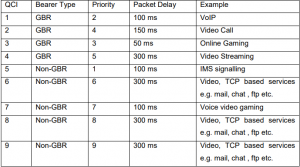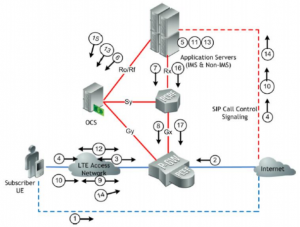VoLTE Call Flow:
Turing on the VoLTE-enabled devices (e.g., smartphones) connects it to the LTE network infrastructure. Then, two default EPS bearers are assigned – one for SIP signaling with a non-GBR QCI value of 5 and the other for the LTE network with a non-GBR QCI value (from 5 to 9).
The QoS Class Identifier (QCI) defines the level of acceptable latency for various types of traffic. The values are specified in the 3GPP standards. The table below compiles these values with other parameters.

VoLTE Call Flow Scenario:

1. The mobile subscriber indicates on LTE-enabled smartphone the request to make a VoIP call.
2. LTE identifies a Packet Data Network (PDN) Gateway (P-GW) that offers a connection to the IMS network.
3. A Default bearer is set by LTE for SIP from the subscriber to the selected P-GW. The default EPS bearer is set with a QoS Class Identifier (QCI) value of 5 (the value required for SIP signaling).
4. The smartphone sends a SIP invitation message to the IMS network. A Session Description Protocol (SDP) exists in the SIP message that carries the QoS requirement. Despite that SIP messages are carried through the LTE network, the content of the message is not known to the LTE network.
5. The required QoS setting is extracted from the SIP message by the IMS network.
6. If a charging policy applies, then the IMS network sends an initial diameter Credit Control Request (CCR) to the Online Charging System (OCS) over the Ro interface and an initial amount of credit is reserved anticipating the need to precisely meter flow of data during the call.
7. From the IMS network, the QoS requirement is sent through the Rx interface (using the Diameter protocol) to the Policy Control and Charging Ruling Function (PCRF).
8. The PCRF makes actionable charging and QoS rules and sends these through the Gx interface to the Policy and Charging Enforcement Function (PCEF) that exists with the P-GW in the LTE network.
9. The P-GW now sends a request to establish a separate “dedicated bearer” (with a QCI value of 1) to the smartphone.
10. After the receipt of the smartphone’s confirmation that states LTE can support the new dedicated bearer, it sends a SIP “UPDATE” message to the IMS network.
11. The setup process is completed by the IMS network and then the call is established.
12. Bidirectional VoIP call packets flow inside the LTE network (to the P-GW) and smartphone
13. As for charging, the IMS network demands credit from the OCS during the call (e.g., every 10 seconds). If the credit does not exist, a 402 (payment required) message is sent back to the smartphone and the call is cancelled. The call is ended if the credit expires during the call.
14. When the call gets terminated, a SIP “BYE” message is sent to the IMS network by the smartphone.
15. A diameter CCR termination request is sent to the OCS by the IMS network, which in return ends the charging metering and starts actions to collect IMS billing records.
16. The PCRF is notified of call termination by the IMS network.
17. The PCRF tells the PCEF to shut down the LTE billing, and tells the P-GW to destroy the dedicated bearer established for the VoIP call.
References:
1. GSA Evolution to LTE report – VoLTE global status (Page 87ff). 2. Voice over LTE: The new mobile voice; Alcatel-Lucent
3. Voice over LTE: Challenges and Opportunities: An Industry Whitepaper; Sandvine
4. Addressing the Challenges of VoLTE Implementation by Anritsu; https://dl.cdn- anritsu.com/en-gb/test…/RTD_VoLTE_IMS_Briefing_Note.pdf
5. https://en.wikipedia.org/wiki/Voice_over_LTE#Deployment
